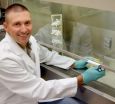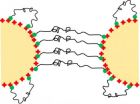(Press-News.org) Dallas (SMU) — Smart phones and mobile devices are on the cusp of revolutionizing health care, armed with mobile health ("mHealth") apps capable of providing everything from cardiac measurements to sonograms.
While tremendous potential exists to broaden access to medical treatment and control costs, several health law experts say in a just-published New England Journal of Medicine (NEJM) report that more oversight is needed by the U.S. Food and Drug Administration (FDA) to ensure consumer confidence and safety. Out of some 100,000 mHealth apps on the market, only about 100 have been cleared by the FDA, while opponents see the FDA as deterrents to innovation — and profits.
"Consumers will be spending a lot of money on these products, and venture capital is flying into the industry," says the article's lead author, SMU Dedman School of Law Associate Dean of Research Nathan Cortez, adding that by 2017 mHealth apps are expected earn $26 billion— up from $2.4 billion in 2013.
The FDA needs "additional funding and in-house technical expertise to oversee the ongoing flood of mHealth products," the authors note. An under-regulated mobile health industry could create "a Wild West" market, says Cortez, who has conducted extensive research into FDA regulation of mobile health technologies.
"Most consumers take mobile health app claims at face value, and think that because they're available through a trusted retailer like the iTunes Store, they must have been reviewed by the FDA, which isn't usually the case," Cortez says.
Cortez, who also serves as an associate professor in SMU's Dedman School of Law, co-wrote the NEJM article with Harvard Law School Professor I. Glenn Cohen, faculty director of the Petrie-Flom Center for Health Law Policy, Biotechnology & Bioethics, and author of Human Subjects Research Regulation: Perspectives on the Future (MIT Press, 2014) and Aaron S. Kesselheim, associate professor of medicine at Brigham and Women's Hospital/Harvard Medical School.
"Although the vast majority of mHealth products are very low-risk, some apps make promises they can't fulfill, and others make errors that could harm patients," Cortez notes, pointing out that life-threatening technical mistakes are not only possible – they also have occurred.
One of several examples cited in the study includes Sanofi Aventis' 2012 recall of a diabetes app that miscalculated insulin dosages.
Several Congressional bills have been proposed to strengthen FDA jurisdiction over mHealth products, with one proposing the creation of a new Office of Wireless Health Technology within the administration, the article notes. Meanwhile, more restrictive bills also have been introduced to keep the FDA from regulating "clinical software" or "applying a complex regulatory framework could inhibit future growth and innovation in this promising market."
"The conventional wisdom is that FDA regulation will stifle innovation, and that's a very short-term way to think about this," Cortez says. "Most Silicon Valley firms aren't used to much federal regulation, and Internet technologies have been subject to very little federal oversight."
If dangerous errors and disproven product benefits are allowed to proliferate, "some very useful products will be undermined by widespread consumer distrust," Cortez contends.
"We're trying to push lawmakers to empower the FDA, not hamstring it," he says. "Clarity will help the industry create products more helpful than harmful."
INFORMATION:
SMU is a nationally ranked private university in Dallas founded 100 years ago. Today, SMU enrolls nearly 11,000 students who benefit from the academic opportunities and international reach of seven degree-granting schools.
SMU Dedman School of Law was founded in 1925 and named Dedman School of Law in 2001 in honor of Dallas benefactors Nancy and Robert H. Dedman, Sr., and their family. SMU Dedman Law offers both a full-time, J.D. program, and a part-time evening J.D. program; two joint degree programs, J.D./M.B.A. and J.D/M.A. in economics; four graduate degree programs, LL.M. program for foreign law school graduates, LL.M. in Taxation, general LL.M., and an S.J.D. program. The law school enjoys a national and international reputation of distinction, with graduates that have distinguished themselves as global leaders in law, business and government, and as prominent members of the judiciary.
Booming mobile health app market needs more FDA oversight for consumer safety, confidence
Health law expert: Under-regulated 'mHealth' industry could create 'Wild West' market
2014-07-28
ELSE PRESS RELEASES FROM THIS DATE:
Two-step decision tree analysis helps inform updates of RT best practices, quality standards
2014-07-28
Fairfax, Va., July 28, 2014—A two-step decision tree analysis, incorporating Donabedian's model, is a feasible process to evaluate and distill the many available quality standards, guidelines, recommendations and indicators in order to update national and international quality standards for radiation therapy, according to a study published in the July-August 2014 issue of Practical Radiation Oncology (PRO), the official clinical practice journal of the American Society for Radiation Oncology (ASTRO).
Guidelines, recommendations and indicators may be utilized to develop ...
Researchers identify potential biomarker for AD
2014-07-28
(Boston)-- Researchers from Boston University School of Medicine (BUSM) report variants in a new gene, PLXNA4, which may increase the risk of developing Alzheimer's disease (AD). The discovery of this novel genetic association may lead to new drug treatment options that target PLXNA4 specifically. These findings appear in the Annals of Neurology.
AD is the most frequent age-related dementia affecting 5.4 million Americans including 13 percent of people age 65 and older, and more than 40 percent of people age 85 and older. Genetic factors account for much of the risk for ...
Researcher using next-generation sequencing to rapidly identify pathogens
2014-07-28
MANHATTAN, Kansas — He calls himself the bug hunter, but the target of his work consists of viruses that can only be found and identified with special methods and instruments. Benjamin Hause, an assistant research professor at the Kansas State Veterinary Diagnostic Laboratory at Kansas State University, recently published an article about one of his discoveries, porcine enterovirus G, which is an important find in the United States.
"We had isolated a virus in cells, but didn't know what it was," Hause said. "We used next-generation sequencing to identify it, and it turned ...
Preschoolers with special needs benefit from peers' strong language skills
2014-07-28
The guiding philosophy for educating children with disabilities has been to integrate them as much as possible into a normal classroom environment, with the hope that peers' skills will help bring them up to speed. A new study provides empirical evidence that peers really can have an impact on a child's language abilities, for better or worse.
While peers with strong language skills can help boost their classmates' abilities, being surrounded by peers with weak skills may hinder kids' language development.
The findings are published in Psychological Science, a journal ...
Unhealthy habits more than double risk of metabolic syndrome in childhood cancer survivors
2014-07-28
A St. Jude Children's Research Hospital study found that 73 percent of adult survivors of childhood cancer more than doubled their risk of developing metabolic syndrome and related health problems by failing to follow a heart-healthy lifestyle. The results appear in the current issue of the journal Cancer.
Almost 32 percent of the 1,598 adult survivors of childhood cancer in the study had metabolic syndrome, an umbrella term for health risk factors like high blood pressure, abdominal obesity, elevated triglyceride and other abnormalities that often occur together. The ...
Seeing is bead-lieving
2014-07-28
HOUSTON – (July 28, 2014) – Rice University researchers are using magnetic beads and DNA "springs" to create chains of varying flexibility that can be used as microscale models for polymer macromolecules.
The experiment is visual proof that "bead-spring" polymers, introduced as theory in the 1950s, can be made as stiff or as flexible as required and should be of interest to materials scientists who study the basic physics of polymers
The work led by Rice chemical and biomolecular engineer Sibani Lisa Biswal and graduate student Julie Byrom was published this month in ...
Mutations from Venus, mutations from Mars
2014-07-28
Some 15% of adults suffer from fertility problems, many of these due to genetic factors. This is something of a paradox: We might expect such genes, which reduce an individual's ability to reproduce, to disappear from the population. Research at the Weizmann Institute of Science that recently appeared in Nature Communications may now have solved this riddle. Not only can it explain the high rates of male fertility problems, it may open new avenues in understanding the causes of genetic diseases and their treatment.
Various theories explain the survival of harmful mutations: ...
Measuring the smallest magnets
2014-07-28
Imagine trying to measure a tennis ball that bounces wildly, every time to a distance a million times its own size. The bouncing obviously creates enormous "background noise" that interferes with the measurement. But if you attach the ball directly to a measuring device, so they bounce together, you can eliminate the noise problem.
As reported recently in Nature, physicists at the Weizmann Institute of Science used a similar trick to measure the interaction between the smallest possible magnets – two single electrons – after neutralizing magnetic noise that was a million ...
Social network research may boost prairie dog conservation efforts
2014-07-28
Researchers using statistical tools to map social connections in prairie dogs have uncovered relationships that escaped traditional observational techniques, shedding light on prairie dog communities that may help limit the spread of bubonic plague and guide future conservation efforts. The work was done by researchers from North Carolina State University and the National Evolutionary Synthesis Center (NESCent).
"Prairie dogs are increasingly rare and are subject to bubonic plague," says Dr. Jennifer Verdolin, lead author of a paper on the work and an animal behavior ...
Motivation explains disconnect between testing and real-life functioning for seniors
2014-07-28
A psychology researcher at North Carolina State University is proposing a new theory to explain why older adults show declining cognitive ability with age, but don't necessarily show declines in the workplace or daily life. One key appears to be how motivated older adults are to maintain focus on cognitive tasks.
"My research team and I wanted to explain the difference we see in cognitive performance in different settings," says Dr. Tom Hess, a professor of psychology at NC State and author of a paper describing the theory. "For example, laboratory tests almost universally ...
LAST 30 PRESS RELEASES:
NTIDE: Disability employment holds steady after data hiatus
Social lives of viruses affect antiviral resistance
Dose of psilocybin, dash of rabies point to treatment for depression
Helping health care providers navigate social, political, and legal barriers to patient care
Barrow Neurological Institute, University of Calgary study urges “major change” to migraine treatment in Emergency Departments
Using smartphones to improve disaster search and rescue
Robust new photocatalyst paves the way for cleaner hydrogen peroxide production and greener chemical manufacturing
Ultrafast material captures toxic PFAS at record speed and capacity
Plant phenolic acids supercharge old antibiotics against multidrug resistant E. coli
UNC-Chapel Hill study shows AI can dramatically speed up digitizing natural history collections
OYE Therapeutics closes $5M convertible note round, advancing toward clinical development
Membrane ‘neighborhood’ helps transporter protein regulate cell signaling
Naval aviator turned NPS doctoral student earns national recognition for applied quantum research
Astronomers watch stars explode in real time through new images
Carbon-negative building material developed at Worcester Polytechnic Institute published in matter
Free radicals caught in the act with slow spectroscopy
New research highlights Syntax Bio’s platform for simple yet powerful programming of human stem cells
Researchers from the HSE University investigated reading in adolescents
Penn Nursing study: Virtual nursing programs in hospitals fall short of expectations
Although public overwhelmingly supports hepatitis B vaccine for a newborn, partisan differences exist
DFW backs UTA research to bolster flood resilience
AI brain scan model identifies stroke, brain tumors and aneurysms – helping radiologists triage and speed up diagnoses
U.S. News & World Report gives Hebrew Rehabilitation Center highest rating
Optica and DPG name Antoine Browaeys 2026 Herbert Walther Award recipient
The presence of a gun in the home increases the risk of suicide by three to five times
PFAS exposure and endocrine disruption among women
Vaccines and the 2024 US presidential election
New approach narrows uncertainty in future warming and remaining carbon budget for 2 °C
When pregnancy emergencies collide with state abortion bans
American College of Cardiology supports front of package nutrition labeling
[Press-News.org] Booming mobile health app market needs more FDA oversight for consumer safety, confidenceHealth law expert: Under-regulated 'mHealth' industry could create 'Wild West' market




